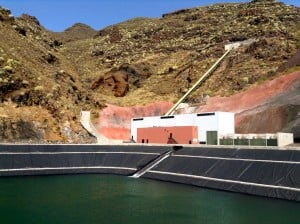
Water storage facility at El Hierro, Canary Islands (Spain). The small island anticipates it will operate with completely renewable energy by end of this year. Source: Lauren Frayer/NPR
Most people have never heard of El Hierro, westernmost of the Spanish-controlled Canary Islands off the coast of Africa. But this tiny outpost, population 10,000, may well become a model for larger communities and countries seeking energy independence. By the end of the year the island expects to generate the entirety of its energy needs from renewable sources.
Because of its remote location El Hierro has never been connected to Spain’s power grid; instead it has received about 6,600 tons of fuel per year delivered by barge for use in diesel-powered generators. This costly and environmentally unfriendly process will soon be completely eliminated: 100 percent of the island’s electricity will derive from wind and hydroelectric power channeled through a newly built processing plant.
Even more remarkably, the technology being used is not at all new: an engineer at the new power plant admitted, “The wind machines, we basically ordered out of [a] catalog.” What is innovative is a system for combining wind and water power. When the wind is howling — quite often on the tiny island in the middle of the Atlantic — windmills start rolling to generate power. Declines in wind speed are measured by sensors, which automatically start water flowing through turbines at the power plant. The switch from wind to hydro happens within seconds without any interruption in electricity flow.
Regardless of increases in oil prices and reduction in oil supply in the future, El Hierro will be set for all of its energy needs. Of course, the question remains whether or not a system like this can be replicated on a larger scale. But it’s certainly a development the U.S. would be wise to keep an eye on, especially if presently operating renewable sources can be adapted to run on the El Hierro model.
It seems worth investigating to me. Hopefully the powers that be will agree.